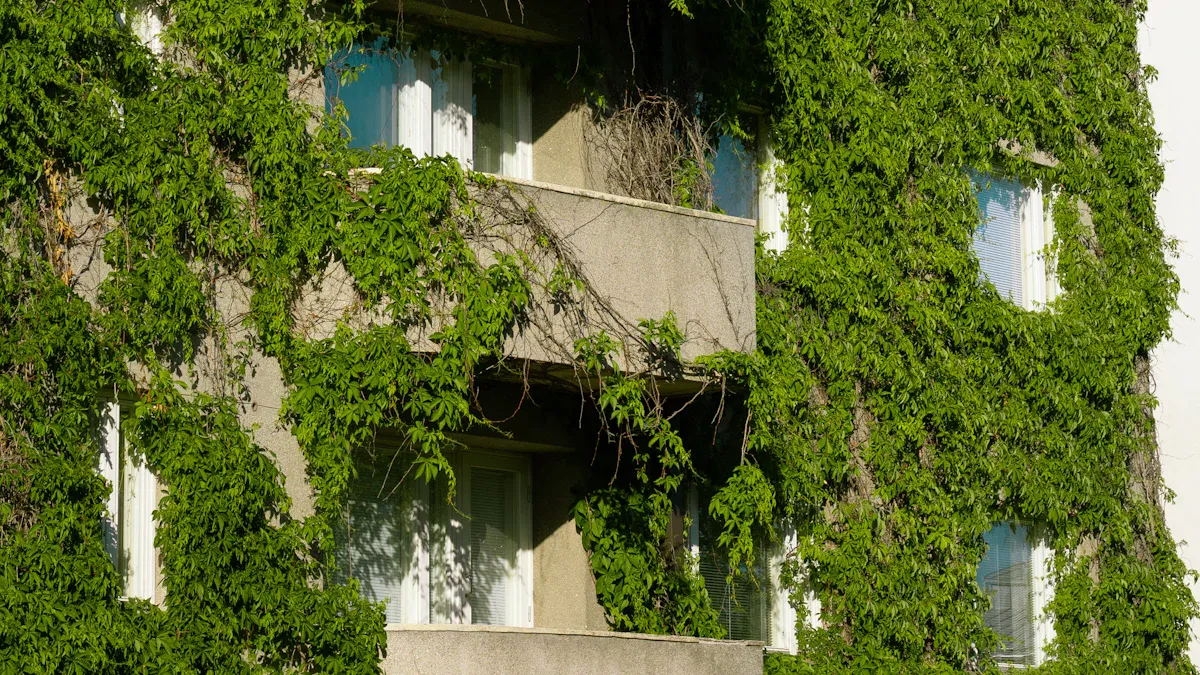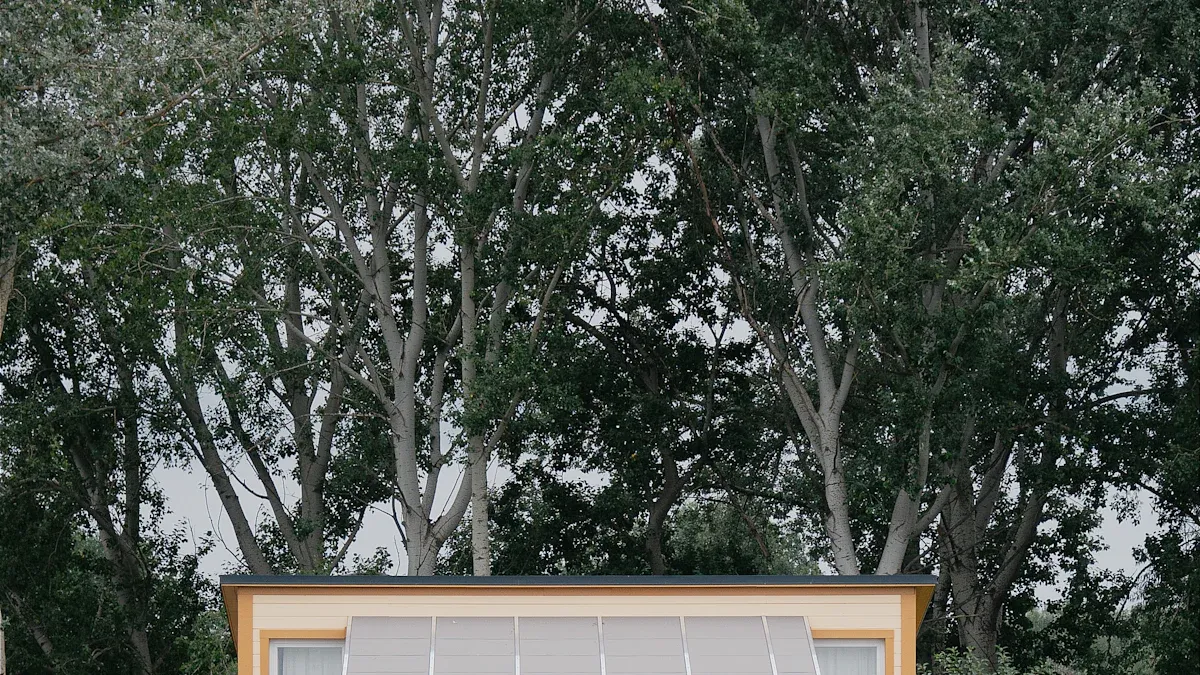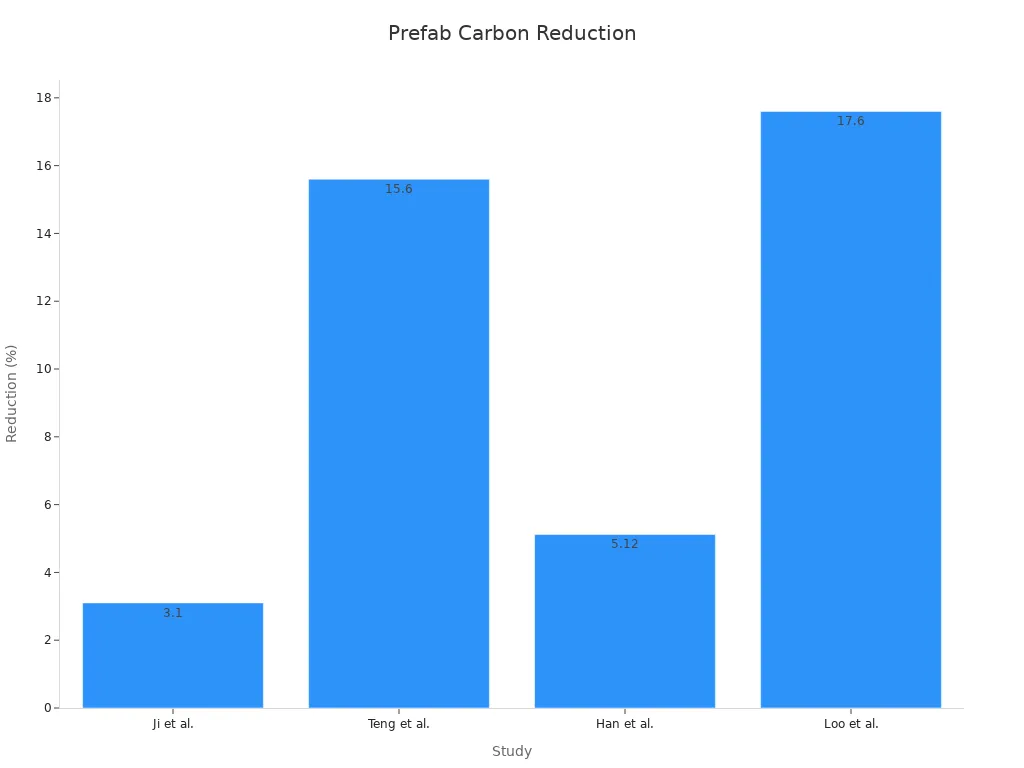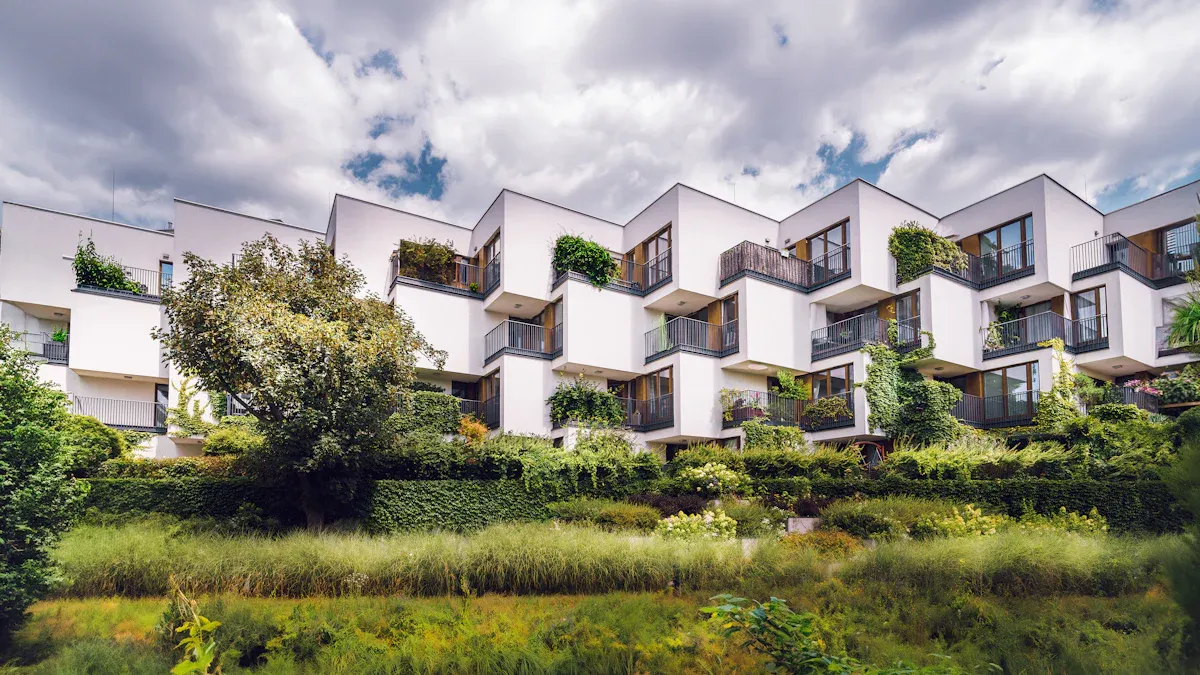
Umweltfreundliche Prefab-Häuser Bieten Sie eine nachhaltige und innovative Lösung an, um modernen Wohnbedürfnissen gerecht zu werden. Diese Prefab -Häuser reduzieren die Treibhausgasemissionen im Vergleich zu herkömmlichen Baumethoden erheblich um bis zu 8,06%. Ausgestattet mit fortschrittlichen energieeffizienten Systemen, einschließlich PV-Sonnenkollektoren, minimieren sie die Kohlenstoffemissionen und verringern den Energieverbrauch um 87,6 kWh/m². Als Bedarf an Erschwingliche Wohnraum steigt fort, diese umweltfreundlichen Prefab-Häuser stellen die Urbanisierungsprobleme mit kreativen Designs wie der RaumkapselhausBereitstellung kompakter und nachhaltiger Wohnräume.
Environmental Benefits of Eco-Friendly Prefab Houses

Energieeffizienz und reduzierter CO2 -Fußabdruck
Eco-friendly prefab houses excel in energy efficiency, significantly reducing their carbon footprint. These homes often incorporate advanced insulation, energy-efficient HVAC systems, and LED lighting, which collectively lower operational carbon emissions. Additionally, integrating renewable energy sources, such as solar panels or wind turbines, further decreases reliance on fossil fuels.
A comparative analysis of modular and conventional construction methods highlights the environmental advantages of prefab houses. The table below summarizes findings from various studies:
| Studie | Ergebnisse | Carbon Emission Reduction | Methodik |
|---|---|---|---|
| Ji et al. | 3.1% carbon reduction through prefabrication | 3.1% | Comparative analysis |
| Teng et al. | Average reduction of 15.6% in embodied carbon | 15.6% | Review of empirical studies |
| Du et al. | Carbon reductions of 16.93%, 20.99%, and 6.09% for prefabrication rates of 21%, 42%, and 83% | 16.93%, 20.99%, 6.09% | Life-cycle assessment |
| Han et al. | 5.12% reduction for 46.98% prefabrication rate | 5.12% | Life-cycle assessment |
| Mo et al. | Notable reductions in transportation and on-site emissions | 4.8 kg/m² and 5.7 kg/m² of CO2 | Empirical analysis |
| Loo et al. | 17.6% reduction in total carbon emissions for MiC | 17.6% | Comparative analysis |

By balancing operational and embodied carbon, prefab houses achieve long-term sustainability. Their design ensures reduced energy consumption while maintaining high performance.
Minimal Construction Waste and Resource Optimization
Prefab houses minimize construction waste through precise material usage and efficient manufacturing processes. Unlike traditional construction, which generates significant waste, prefab methods reduce waste by up to 25.85%. This includes reductions in inorganic nonmetallic, organic, metallic, and composite waste.
- Prefabricated projects generate 25.85% less total waste compared to conventional methods.
- Modular construction reduces material usage and excavation waste by 50%.
- On-site waste decreases by more than 15%.
“Currently, an estimated 25% of construction material ends up in landfills. Prefabrication helps reduce waste by optimizing material usage and enabling offcut reuse or recycling.”
These waste reduction strategies not only benefit the environment but also lower costs for builders and homeowners.
Use of Sustainable and Recyclable Materials
Eco-friendly prefab houses prioritize sustainable and recyclable materials, which reduce environmental impact and enhance durability. Using materials with low embodied carbon, such as recycled steel or reclaimed wood, minimizes deforestation and decreases carbon emissions from resource extraction.
- Prefabrication leads to a 15.38% reduction in construction waste compared to traditional methods.
- Modular construction reduces material usage and excavation waste by 50%.
- On-site waste is reduced by more than 15%.
A quantitative study revealed that prefab houses significantly lower embodied energy, resulting in less energy consumption during production and transportation. These materials also offer cost savings and easier maintenance, making them a practical choice for sustainable living.
Affordability and Cost-Effectiveness
Lower Construction Costs Compared to Traditional Homes
Prefab houses offer a kostengünstige Alternative to traditional construction methods. Their streamlined manufacturing process reduces material waste and leverages economies of scale, resulting in significant savings.
- Prefab homes typically cost between $3,800 and $4,800 per square meter, while traditional homes often exhibit greater price variability.
- Labor costs for traditional homes increased by 19.6% in 2022, whereas prefab construction minimizes on-site labor requirements, further lowering expenses.
- Contrary to misconceptions, prefab homes can appreciate in value over time, making them a sound financial investment.
By optimizing resources and reducing waste, prefab houses provide an affordable solution for homeowners seeking high-quality, sustainable living spaces.
Faster Build Times and Reduced Labor Expenses
The efficiency of prefab construction significantly shortens project timelines, leading to reduced labor costs. Prefabrication allows up to 80% of construction activities to occur offsite, minimizing delays caused by weather or logistical challenges.
| Evidenztyp | Beschreibung |
|---|---|
| Speed of Construction | Prefabrication can accelerate construction by as much as 50%. |
| Cost Reduction | Prefab methods can lower overall construction costs by 20%. |
| Labor Activity | Up to 80% of traditional labor occurs offsite, reducing on-site expenses. |
| Productivity Increase | Factory environments double productivity compared to traditional builds. |
| Labor Cost Reduction | Offsite manufacturing reduces labor costs by up to 25%. |
These advantages make prefab houses an attractive option for developers and homeowners alike. Faster build times not only reduce labor expenses but also enable quicker project completion, allowing families to move into their homes sooner.
Long-Term Savings Through Energy Efficiency
Eco-friendly prefab houses deliver substantial long-term savings through energy-efficient designs. Features such as advanced insulation, airtight building envelopes, and passive solar systems reduce energy consumption and operational costs.
| Statistik | Beschreibung |
|---|---|
| 30% reduction | Energy-efficient homes can cut energy consumption by up to 30%. |
| $2,000 annual cost | The average U.S. household spends over $2,000 annually on energy bills. |
| Savings from eco-tech | Eco-friendly technologies significantly lower energy expenses. |
| £11,000 savings | Net-zero carbon homes save up to £11,000 in energy costs over 30 years. |
Research highlights that prefab houses optimize natural light and minimize heat loss, enhancing indoor comfort while reducing reliance on artificial lighting and heating systems. These energy-efficient features not only lower utility bills but also increase the resale value of the property, making prefab houses a smart choice for cost-conscious homeowners.
Durability and Performance
Advanced Materials Like SIPs (Structural Insulated Panels)
Structural Insulated Panels (SIPs) are revolutionizing prefab houses by offering superior strength and thermal performance. These panels consist of an insulating foam core sandwiched between two structural facings, typically made of oriented strand board (OSB). Their design enhances stiffness and structural behavior, making them ideal for sustainable housing.
| Studientitel | Schlüsselergebnisse |
|---|---|
| Experimental and numerical studies on the thermal performance of SIP splines | SIPs improve structural stiffness and outperform conventional methods. |
| Experimental study of thermal and airtightness performance in cold climates | SIPs provide high-performance building envelopes for cold climates. |
| Development of SIPs from wood-composite boards and natural rubber foam | SIPs exhibit excellent mechanical properties and water resistance. |
By combining durability with energy efficiency, SIPs contribute to the long-term sustainability of prefab houses.
Weather Resistance and Longevity
Prefab houses demonstrate remarkable resilience against extreme weather conditions. Manufacturers design these homes to withstand hurricanes, high winds, and heavy snowfall. For instance, Deltec Homes has never lost a structure to hurricanes since 1968, even during major storms like Sandy and Katrina. The most significant damage reported was limited to minor shingle loss.
This level of durability stems from precise engineering and the use of robust materials. Prefab construction also minimizes exposure to the elements during assembly, reducing risks of weather-related damage. These features ensure that prefab houses maintain their structural integrity over decades, offering homeowners peace of mind.
Low Maintenance Requirements
Eco-friendly prefab houses require minimal maintenance, thanks to their efficient designs and durable materials. Facility maintenance and utilities typically account for 20-30% of total operating expenses, but prefab homes help reduce these costs through energy-efficient systems.
- Energy-efficient designs lower utility bills, reducing overall maintenance expenses.
- Regular equipment servicing can cut repair costs by 15-20%, ensuring predictable expenses.
- High-quality materials used in prefab construction enhance longevity, minimizing the need for frequent repairs.
These cost-saving benefits make prefab houses an attractive option for homeowners seeking low-maintenance, sustainable living solutions.
Top Eco-Friendly Prefab Home Manufacturers

Blu Homes: Offers energy-efficient prefab homes with modern designs and sustainable materials
Blu Homes stands out for its commitment to sustainability and innovative designs. The company integrates advanced technologies to create energy-efficient prefab houses that cater to modern living needs. Their LUXE Series exemplifies this dedication, offering homes equipped with solar panels and green roofs as standard features. Blu Homes also emphasizes efficient material use and renewable resources, ensuring minimal environmental impact.
| Besonderheit | Beschreibung |
|---|---|
| Sustainable Practices | Emphasizes efficient material use and renewable resources. |
| Modulares Design | Allows for customizable features catering to individual consumer needs. |
| Fast Assembly | Proprietary technology enables quick assembly without compromising efficiency. |
| Luxusserie | Integriert Sonnenkollektoren und grüne Dächer als Standardoptionen und zeigen Verpflichtungen für Nachhaltigkeit. |
Dieser modulare Ansatz verbessert nicht nur die Anpassung, sondern beschleunigt auch die Bauzeitpläne, wodurch Blu-Häuser zu einem führenden Anbieter von umweltfreundlichem Präfabosengehäuse sind.
Methodenhäuser: spezialisiert auf anpassbare, umweltfreundliche modulare Häuser mit Schwerpunkt auf Nachhaltigkeit
Method Homes liefert vielseitige Prefab -Häuser, die auf individuelle Vorlieben zugeschnitten sind. Ihre Entwürfe passen sich nahtlos an verschiedene lebende Stile an, sei es ländlich oder vorstädtisch. Das Unternehmen verwendet nachhaltige Materialien aus der Region, um die Auswirkungen auf die Umwelt zu reduzieren, und hält sich an Zertifizierungen wie Leed, Energy Star und Passiv House Standards.
- Materialien aus der Region minimieren die Umweltauswirkungen.
- Zertifizierungen validieren umweltfreundliche Baupraktiken.
- Recyclingprogramme sollten Materialien während des Baus wiedergeben.
- Mehrere Grundrisse bieten unterschiedlichen Lebensstilen.
Method Homes kombiniert die Funktionalität mit Nachhaltigkeit und bietet Prefab -Häuser an, die mit dem modernen grünem Lebensstandard übereinstimmen.
LivingHomes by Plant Prefab: Bietet Null-Energie, LEED-zertifizierte Prefab-Häuser mit innovativen Designs
Livinghomes von Pflanzenprefabs definiert nachhaltige Wohnungen mit seinen Häusern mit null Energie. Diese Strukturen erreichen eine LEED -Zertifizierung und gewährleisten eine hohe Umweltleistung. Das Unternehmen umfasst modernste Designs, die die Energieeffizienz optimieren und die CO2-Fußabdrücke reduzieren.
Livinghomes konzentriert sich darauf, Räume zu schaffen, die Ästhetik mit Nachhaltigkeit in Einklang bringen. Ihre Prefab -Häuser integrieren passive Sonnensysteme und fortschrittliche Isolierung, wodurch der Komfort in Innenräumen verbessert und gleichzeitig den Energieverbrauch gesenkt wird. Dieser Ansatz macht Livinghomes zu einer Top-Wahl für umweltbewusste Hausbesitzer.
Ningbo Cheerme Intelligent Furniture Co., Ltd.: Entwurf und Herstellung modularer Vorbereitungshäuser mit Schwerpunkt auf Nachhaltigkeit, Kosteneinsparungen und Kohlenstoffneutralität
Ningbo Cheerme Intelligent Furniture Co., Ltd. Excels bei der Erstellung modularer Prefab -Häuser, die Nachhaltigkeit und Erschwinglichkeit priorisieren. Das Unternehmen baut durch modulares Design und Baugruppe ein nachhaltiges vorgefertigtes Raum -Ökosystem. Ihre Produkte nutzen umweltfreundliche Sperrholz- und Polyesterfaser-Schallabsorbungsplatten und unterstützen die Ziele der Kohlenstoffneutralität.
- Das modulare Design verbessert die Effizienz und Skalierbarkeit.
- Nachhaltige Materialien verringern die Auswirkungen auf die Umwelt.
- Die schnelle Montage minimiert Abfall und spart Kosten.
Der innovative Ansatz von Cheerme sorgt für die Kosteneinsparung für Benutzer und fördert das Green Living. Ihre Prefab -Häuser veranschaulichen die Zukunft nachhaltiger Wohnungen.
Umweltfreundliche Prefab-Häuser Bieten Sie Erschwinglichkeit, Nachhaltigkeit und Energieeffizienz und machen sie zu einer praktischen Wahl für das moderne Leben. Modulare Konstruktionen reduzieren Materialabfälle, während energieeffiziente Merkmale wie überlegene Isolierung und Sonnenkollektoren die Nutzungskosten senken. Diese Häuser fördern das grünes Leben, indem sie die Kohlenstoffemissionen minimieren und nachhaltige Praktiken unterstützen. Die Erkundung von Prefab-Wohnungsoptionen ermöglicht Einzelpersonen, umweltfreundliche Lebensstile zu nutzen.
FAQ
Was unterscheidet sich umweltfreundliche Präfithäuser von traditionellen Häusern?
Umweltfreundliche Prefab-Häuser verwenden nachhaltige Materialien, minimieren Bauabfälle und enthalten energieeffiziente Konstruktionen. Diese Merkmale reduzieren die Auswirkungen auf die Umwelt und fördern langfristige Kosteneinsparungen.
Wie lange dauert es, um ein umweltfreundliches Präfaba-Haus zu bauen?
Der Bau von Prefab-Häusern dauert normalerweise 8-12 Wochen. Die Offsite -Herstellung beschleunigt die Zeitpläne und sorgt für eine schnellere Lieferung im Vergleich zu herkömmlichen Baumethoden.
Sind umweltfreundliche Präfithäuser anpassbar?
Ja, viele Hersteller bieten anpassbare Designs an. Käufer können Layouts, Materialien und energieeffiziente Merkmale auswählen, die ihren Vorlieben und Nachhaltigkeitszielen entsprechen.

